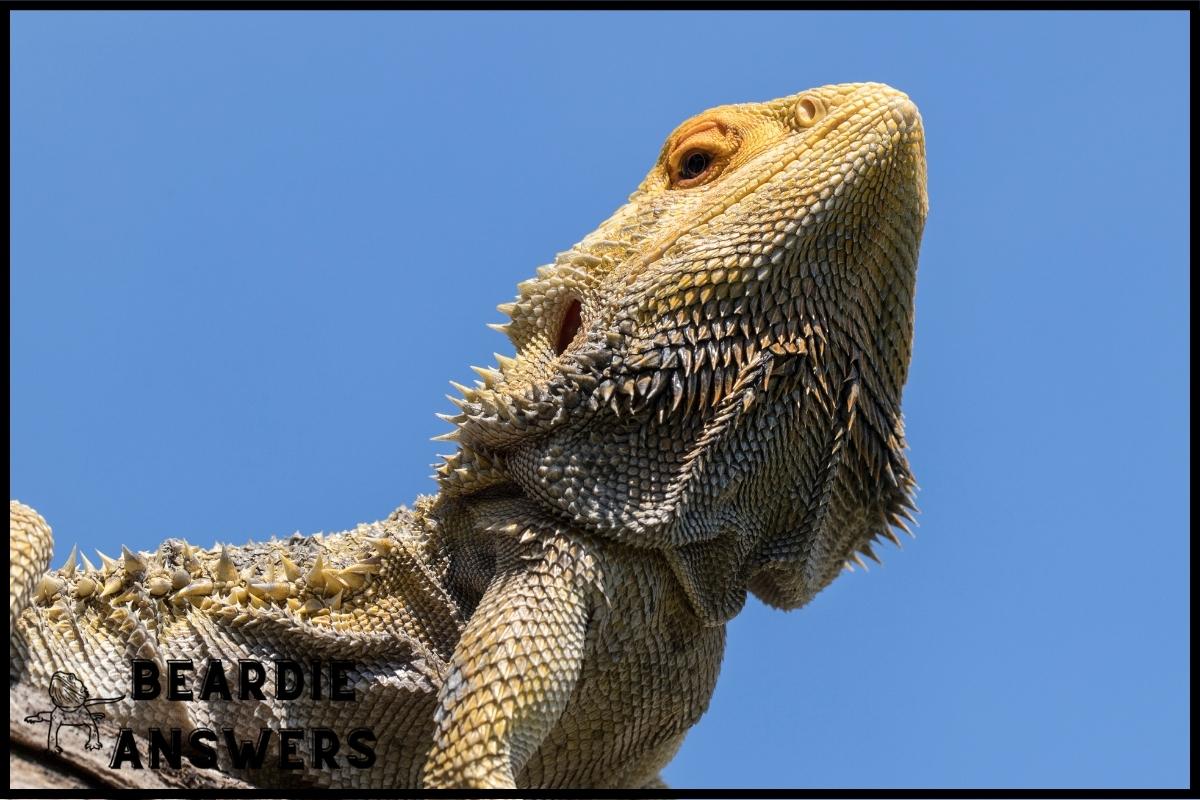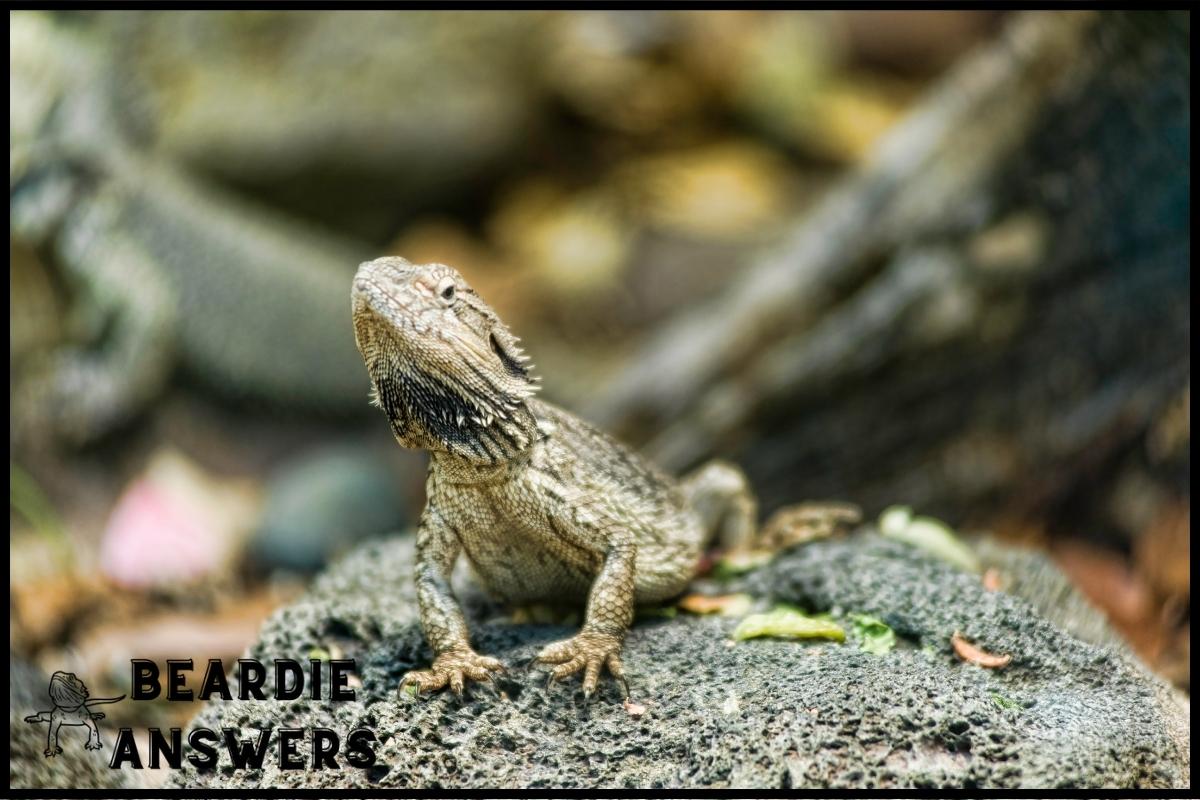[su_note note_color=”#eee”]
Setting up the right bearded dragon habitat is essential for their health and well-being. It’s important to provide a tank with proper heating, lighting, substrate and decorations so they can thrive in captivity.
Having an ideal environment that replicates their natural habitats will help your pet live happily and comfortably. Let’s take a look at what you need to do to create the perfect home for your beloved reptile!
What You'll Learn
Container Requirements
Setting up a bearded dragon habitat is like putting together the pieces of an intricate puzzle. It requires careful consideration and attention to detail in order to meet all its dietary needs, housing requirements, ventilation needs, water sources, and thermoregulation methods.
In terms of diet, your bearded dragon will need fresh fruits and vegetables as well as crickets or other insects for protein. You should also provide them with calcium supplements twice a week in order to support healthy bone growth.
The enclosure you choose must be large enough for them to move around comfortably – at least 20 gallons for one adult beardie. Make sure that it has adequate ventilation but not too much draft to prevent respiratory infections. Provide plenty of hiding spots so they feel safe and secure. Lastly, make sure there’s easy access to both fresh drinking water and bathing water – this can be achieved through shallow dishes filled with dechlorinated tap water or distilled water.
Temperature regulation is key when creating a healthy environment for your pet reptile…
Temperature Regulation
The temperature within the bearded dragon’s habitat is important and must be closely monitored. Seasonal variation should be taken into account when setting up a comfortable environment for your pet.
Establishing basking spots with heat mats or lamps, as well as using thermostats to monitor temperatures are all necessary steps in this process.
Heat lamps should provide between 95-105 degrees Fahrenheit during the day, while at night the temperature can drop down to 70-75 degrees.
Heat sources such as these will help maintain consistent temperatures throughout their home; however, UVB exposure also plays an important role in keeping your beardie healthy and happy.
Uvb Exposure
UVB exposure is essential for a healthy bearded dragon habitat. Proper UVB spectrum should be provided by using either a fluorescent or mercury vapor lamp, depending on the size of your tank and basking spots available.
Risk factors such as window glass can absorb up to 50% of the light’s UVB rays, so it’s important that proper cage placement is taken into account when setting up your tank.
In addition to providing necessary calcium absorption, UVB lighting also helps regulate day-night cycles in your bearded dragon’s environment.
It’s important to monitor how much time your pet spends under their heat and UVB lights because too much exposure can cause health problems. For these reasons, it’s best to keep an eye on them while they bask during the daylight hours.
With careful consideration given to all aspects of lighting needs, you will ensure that your pet gets optimal benefits from their UVB exposure.
Humidity levels are another factor that need to be monitored closely when maintaining a suitable environment for your bearded dragon…
Humidity Needs
UVB exposure is key for bearded dragons, but it’s also important to consider their humidity needs. Humidity levels should remain between 30-40%, and there are a few ways to achieve this.
Moisture control can be achieved by having water bowls in the tank, as well as misting systems. Ventilation systems help keep air flow moving throughout the habitat, which helps maintain proper humidity levels. Additionally, ventilation will help prevent stagnant air from building up in the enclosure – something that could cause respiratory issues if left unchecked.
These components all work together to create an environment suitable for your dragon’s health and wellbeing. Having established the importance of humidity levels, it’s time to look at another essential element: substrate selection.
Substrate Selection
Let’s talk about substrate selection for bearded dragon habitat set ups. We need to consider the types of substrate to use, as well as making sure it’s safe.
Types Of Substrate
When selecting a substrate for your bearded dragon habitat, it’s important to consider the type of soil that best meets their needs.
There are many options available, such as sand, coconut husk fiber and calcium-rich substrates like crushed oyster shells or reptile carpeting.
Each one has its own advantages and disadvantages in terms of nutrition, cleaning and temperature monitoring.
A sandy option is great because it absorbs heat quickly while providing good drainage, but can be difficult to clean.
Coconut husk fiber provides better moisture retention than sand and helps promote healthy digestion, however it should be replaced often due to bacteria build up over time.
Finally, calcium-rich substrates help provide essential nutrients for your beardie’s diet; however they must be monitored closely as temperatures have a tendency to spike when using these materials.
Ultimately the choice comes down to personal preference – just remember that whichever you choose should keep your pet safe and comfortable!
Substrate Safety
When selecting a substrate, it’s important to consider not only the dietary needs of your pet, but also the size and ventilation requirements of their enclosure.
It’s essential to make sure that there is adequate airflow in order to prevent harmful bacteria from building up over time – something that can be easily overlooked when opting for a calcium-rich substrate.
Additionally, you’ll want to ensure any material you choose won’t pose a risk of ingestion or inhalation by your dragon.
With these precautions taken into account, you’re well on your way towards creating a safe habitat for your beardie!
Decorations And Enrichment
Decorations and Enrichment are an important part of any bearded dragon habitat set up. While heating lighting substrate provide the basic necessities, decorations and enrichment can transform a tank into a stimulating environment.
Adding toys, plants, hiding spots, natural materials, and cage furniture is essential to make sure that your pet has plenty to do throughout the day:
- Toys can help keep them active during playtime
- Plants add visual interest and encourage exploration in their habitats
- Hiding spots provide areas where they can retreat and relax away from light or noise sources
- Natural materials such as wood or stones give texture and help create more realistic environments for reptiles
- Cage furniture helps liven up their space while also aiding climbers with traction on slippery surfaces
Providing these types of items will ensure that your beardie’s enclosure is interesting, safe, and comfortable – giving you peace of mind knowing that your reptilian companion is happy in its home.
Conclusion
To conclude, creating a proper habitat for your bearded dragon is essential to its health and happiness. It’s important to remember that they are not just like any other pet; they need specific parameters in order to thrive.
With the right tank requirements, temperature regulation, UVB exposure, humidity needs, substrate selection, decorations and enrichment you’ll be able to provide your beardy with an environment that it will love!
It’s estimated that around 40% of all reptiles die within one year of being acquired due to improper care. This statistic should evoke urgency in owners when setting up their reptile habitats.
Don’t let this happen to your beloved pet; make sure you do everything you can from day one to ensure its safety and wellbeing.
At the end of the day, taking good care of your bearded dragon requires dedication but it pays off tenfold when you get rewarded with happy days spent watching them explore their enclosure or cuddle up on your lap!

Hi! My name is Bryan, I am the “one behind the words” here are BeardieAnswers.com. I believe that providing quality care and nutrition is the best way to ensure the health of your pet. Every beardie is special and deserves the best care and attention. If you have questions about your bearded dragon, please don’t hesitate to ask! View My Full Author Page




